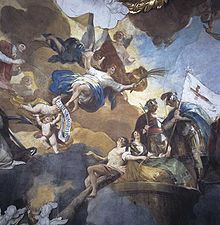 |
| The Back of Saint Mary Major is Maternally Grandiose and Memorable |
Saint Mary Major is called major (maggiore) because of it's greatness: 1) the mother of all Marian Churches since it has the highest rank thereof (the only Marian Major Basilica) and the maggiore (the oldest) in that it is 2) the eldest Marian Church to receive the dignity of Basilica.
However, the oldest church dedicated to Mary is the Catedral-Basílica de Nuestra Señora del Pilar) in Zaragoza, Spain, constructed in the year 40 AD by Saint James (while the Most Blessed Virgin Mary was still alive on the earth)!
It is no accident that Saint Mary Major has been historically so allied to the Spanish! It is the Spanish Major Basilica on many different levels (for starters, the Wikipedia article is originally in Spanish). For example, the Gold on the ceiling is the Spanish gold from the New World put there by Ferdinand and Isabella as a gift to the Spanish Pope Alexander VI under whom America was discovered!
Apparition of Pilar
Main article: Nuestra Señora del Pilar
According to ancient local tradition, soon after the crucifixion and resurrection of Jesus, Saint James was preaching the Gospel in Spain, but was disheartened because of the failure of his mission.[4] Tradition holds that on 2 January 40 AD,[3] while he was deep in prayer by the banks of the Ebro,[6] the Mother of God appeared to him and gave him a small wooden statue of herself and a column of jasper and instructed him to build a church in her honor:[4]
Main article: Nuestra Señora del Pilar
First Chapel
About a year after the believed apparition James is believed to have arranged to build a small chapel in Mary's honor, the first church ever dedicated to the honor of the Virgin Mary. After James returned to Jerusalem, he was executed by Herod Agrippa in about 44 AD, the first apostle to be martyred for his faith. Several of his disciples took his body and returned it for final burial in Spain.[4] This first chapel was eventually destroyed with various other Christian shrines, but the statue and the pillar stayed intact under the protection of the people of Zaragoza.[5]
Expansions
Romanesque Church
Numerous churches have been built upon this site through the years. The tiny chapel built by Saint James later gave way to a basilicalike enclosure during Constantine I's time; subsequently being transformed into Romanesque, then Gothic then Mudéjar styles.[7] The venerated shrines at Zaragoza date to the Christian Reconquest by King Alfonso I in 1118.[8] A church in the Romanesque style was built under the pontificate of Pedro de Librana[7] who is also credited with the oldest written testimonial to the Virgin at Zaragoza.[6]A tympanum on the south wall of this Romanesque church still stands.[7]
Gothic Church
The Romanesque church was damaged by fire in 1434, and reconstruction began in the Mudéjar Gothic style.[7] A Gothic-style church was built in the 15th century but only a few parts of it remain intact or were later restored, including the choir stand and the altarpiece inalabaster by Damián Forment.[9]
Current church
The present spacious church in Baroque style was begun in 1681[6] by Charles II, King of Spainand completed in 1686.[5] The early constructions were supervised by Felipe Sanchez[7] and were later modified by Francisco Herrera the Younger under John of Austria the Younger.[10] In 1725, the Cabildo of Zaragoza decided to change the aspect of the Holy Chapel and commissioned the architect Ventura Rodríguez, who transformed the building into its present dimensions of 130 meters long by 67 wide, with its eleven cupolas and four towers. The area most visited is the eastern part of the chapel, because this is where the Holy Chapel by Ventura Rodríguez (1754) is built, which houses the venerated image of the Virgin. Around the Holy Chapel are the vaults or domes painted with frescoes by Francisco Goya: The Queen of Martyrs and Adoration of the Name of God.[9] By 1718 the church had been vaulted over. However, it was not until 1872 that the final touches were put to these vaults, when the main dome and the final spire were finished.[7]
During the Spanish Civil War of 1936–1939 three bombs were dropped on the church but none of them exploded.[3] Two of them are still on show in the Basilica.
Notable choirmasters include the Baroque composer Joseph Ruiz Samaniego.
































